|
Report
from
Europe
European domestic hardwood production rebounds
Data from the UNECE Timber Committee indicates that
hardwood production across the European sub-region
rebounded during 2010 (the UNECE European sub-region
includes all countries within the continent of Europe plus
Turkey but excluding Russia).
Following an 18% decline in hardwood saw and veneer
log production in the region between 2007 and 2009 to
29.7 million cu.m, production rebounded by 12% to 33.2
million cu.m in 2010.
Significant increases in hardwood log production were
recorded in Romania, Germany, Turkey, and Latvia during
2010. 26.2 million cu.m (78%) of total European
hardwood log production during 2010 was in EU
countries.
Turkey was the largest producer of sawn hardwood in Europe
European production of sawn hardwood followed the same
general trend. A 26% fall in production between 2007 and
2009 was followed by a robust 9% rebound during 2010
(Chart 2). Significant gains in production were in Turkey
(8.8%), Germany (6.6%) and Croatia (5.6%).
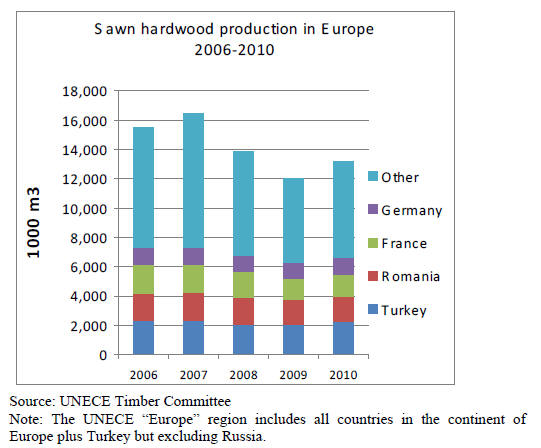
Turkey was the largest producer of sawn hardwood in
Europe in 2010. However most sawn hardwood in Turkey
is produced from low-grade domestic timber, as well as
small-dimension plantation logs and is destined for the
pallet and packaging industry with only a small proportion
earmarked for export.
Germany, France and Romania remain by far the dominant
producers of higher grades of European sawn hardwood.
The rising log harvest in 2010, combined with an
underlying lack of consumption, has meant that there have
been no major hardwood log shortages in Europe in recent
times. Supplies of beech logs have generally been
adequate.
Short-term concerns have occasionally arisen over
supplies of oak logs, particularly with rising demand in
export markets, notably from China, and following severe
winter weather in both 2009 and 2010 which briefly
curtailed harvesting levels.
However oak log supply problems had eased greatly by
the end of the first quarter of 2011 as weather conditions
improved and log exporters were less active at French and
German auction sales.
European domestic production more dominant
Within the EU-25 group of countries, apparent
consumption of sawn hardwood increased by 9.4% during
2010, from 8.7 to 9.6 million cu.m.
While a significant gain, consumption levels were still
well down on levels of over 13 million cu.m which
prevailed prior to the economic crises. The overall figure
also hides important changes in sources of supply and
demand.
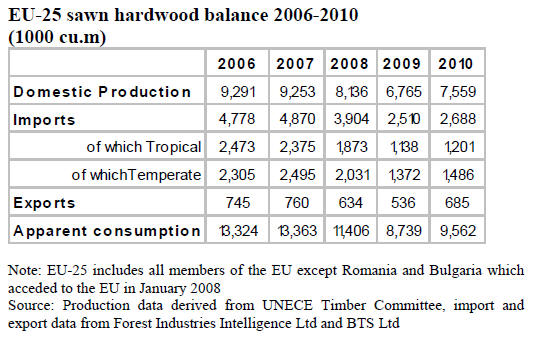
Domestic industry weathered the crisis better than external suppliers
While all wood suppliers into the EU market suffered
severely during the recession, the signs are that the
domestic industry weathered the storm better than most
external suppliers. During the period 2006 to 2010, the
share of domestic hardwood sawn lumber in overall
supply to the EU-25 group of countries increased from
66% to 74%.
The share of non-EU temperate hardwood suppliers
declined from 16% to 15%. However the major loser in
this process has been tropical hardwood which saw share
of European sawn hardwood supply fall from 18% to 12%
in the four year period.
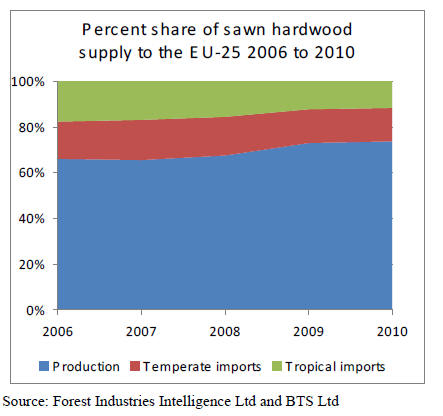
While all major tropical supply countries experienced
some slippage in European market share for sawn
hardwood, the trend was particularly pronounced for
Brazil (share of EU supply falling from 4.1% to 2.9%)
Ivory Coast (share falling from 2% to 1%), and Ghana
(share falling from 0.8% to 0.4%).
Major shift in EU sawn hardwood supply
A number of factors have played a role in this major shift
in European sawn hardwood supply including:
• increased diversion of global hardwood supply
away from Europe to China and emerging
markets;
• a move to smaller stock-holdings and just-in-time
ordering during the credit crunch which has
tended to favour more readily available products
with shorter lead times;
• the willingness of European domestic suppliers to
deliver to the precise specifications of European
manufacturers;
• the willingness of the European state forest sector
to continue to harvest hardwood logs during the
recession despite relatively low log prices;
• the continuing strong fashion for European oak in
the region;
• the development of an expanding range of
treatment techniques allowing use of European
hardwoods for a much wider range of looks and
applications;
and
• environmental concerns which have benefited
FSC and PEFC certified hardwoods, the majority
of which derive from Europe.
Low hardwood demand from cabinet, furniture and
parquet industries
On the demand side, European consumption of sawn
hardwood recovered quite strongly in France, Germany,
and Sweden during 2010 and early 2011. However
consumption has remained at historically low levels in
many European markets, notably Spain, Portugal, and
Italy due to continuing low demand in the cabinet,
furniture and parquet industries.
The strong euro has meant that Europe¡¯s important
furniture sector is coming under particularly intense
pressure from competitors in Asia.
Exports of EU hardwoods recovering
Export markets for European sawn hardwood, particularly
oak and ash, in China and Vietnam have also been
recovering. Between 2009 and 2010, EU-25 sawn
hardwood exports to China increased from 115,000 cu.m
to 205,000 cu.m, while exports to Vietnam increased from
21,000 cu.m to 40,000 cu.m.
In contrast, European sawn hardwood exports to the
Middle East and North Africa have been declining. Recent
political upheaval in this region has resulted in declining
demand, particularly for beech in Egypt, Jordan, Syria,
and Tunisia.
Despite pockets of poor demand, according to the UNECE
Timber Committee, reports from the European hardwood
sawmilling sector have been generally positive in 2011
and there are expectations that overall sales this year may
be 15% to 20% higher than in 2010.
Tropical log imports still close to recession levels
The EU-25 imported 93,400 cu.m of tropical hardwood
logs during the first quarter of 2011, a 6% increase on the
previous quarter, but 1% down on the same quarter in
2010.
Following the dramatic decline in imports from over
200,000 cu.m in the first quarter of 2008 to a low of
88,000 cu.m in the third quarter of 2009, quarterly imports
have stabilised at this lower level.
In addition to the recession, a major factor driving the
recent decline in log imports was Gabon¡¯s imposition of a
log export ban from May 2010 onwards. Rising log
imports from Cameroon, Democratic Republic of Congo,
Republic of Congo, Equatorial Guinea and Liberia have
only partially offset the decline in availability from Gabon.
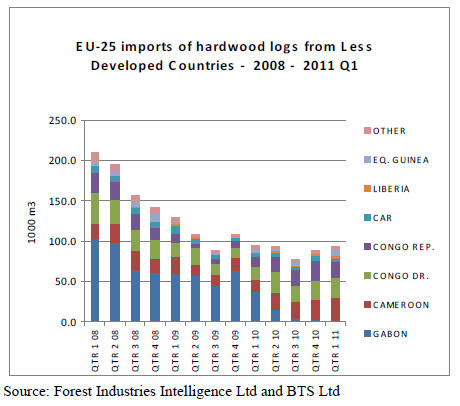
Rise in EU sawn hardwood imports driven by
temperate species
The EU-25 imported 702,000 cu.m of sawn hardwood
during the first quarter of 2011, a 5% increase on the
previous quarter and a 6% increase on the same quarter in
2010.
However tropical sawn hardwood imports of 293,000 cu.m
during the first quarter of 2011 were 1% down on the
previous quarter and only 2% up on the same quarter in
2010.
This compares to temperate hardwood sawn imports of
409,000 cu.m during the first quarter of 2011, up 10% on
the previous quarter and up 9% on the same quarter in
2011. Most recent gains in EU-25 imports of temperate
hardwoods have been made by Croatia and Ukraine.
Recent news is not all bad for tropical hardwoods.
Brazilian sawn hardwood has been regaining some of the
ground lost in the European market, particularly in France
and Belgium.
In the first quarter of 2011, EU-25 imports of sawn
hardwood from Brazil were 56,000 cu.m, up 22% on the
previous quarter. Meanwhile European imports from
Cameroon started 2011 much more strongly than the
previous year, with larger volumes arriving in Belgium,
Netherlands, UK, Ireland and Italy.
Total EU-25 imports of sawn hardwood from Cameroon
reached 92,000 cu.m in the first 3 months of 2011, up 14%
on the same period in 2010.
These gains helped offset relatively weak first quarter
imports of sawn hardwood from Malaysia (58,000 cu.m)
and Ivory Coast (24,000 cu.m).
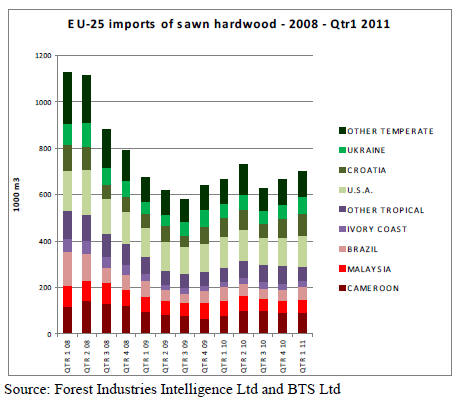
EU hardwood veneer imports weaken again
The EU-25 imported 118,000 cu.m of hardwood veneer
during the first quarter of 2011, an 8% decline on the
previous quarter and a 4% decline on the same quarter in
2010 (Chart 6).
Tropical hardwood veneer imports of 69,000 cu.m during
the first quarter of 2011 were 10% down on the previous
quarter and 4% down on the same quarter in 2010. This
compares to temperate hardwood veneer imports of 60,000
cu.m during the first quarter of 2011, down 2% on the
previous quarter and 3% on the same quarter in 2011.
The continuing weakness of the European veneer trade is
particularly troubling considering the wide range of enduse
sectors for hardwood veneers, the resources committed
to boosting the share of real wood by large veneer
manufacturers, and the decline in Europe¡¯s tropical
hardwood log imports.
European plywood manufacturers might reasonably have
been expected to have offset the decline in availability of
okoume logs by importing more rotary veneer from
Gabon.
However European imports of this commodity have
remained low as manufacturers have been struggling in the
face of tight margins and rising competition from a range
of lower-priced panels. European imports of thicker rotary
veneer for flooring are also depressed as European
flooring output is low due to weak construction growth
and competition from artificial surfaces.
The weak construction sector has also hit mainstream
markets for sliced veneer, including doors, panels and
furniture. The latter sector is struggling in the face of stiff
competition from Chinese manufacturers.
At the same time, real wood veneer has continued to lose
out to artificial surfaces. As demand for sliced veneer has
been increasingly marginalised in mainstream markets,
demand is now focusing more on higher value niche
markets -including high end interior fittings, yachts, and
the car industry - which generate more value but absorb
lower volumes.
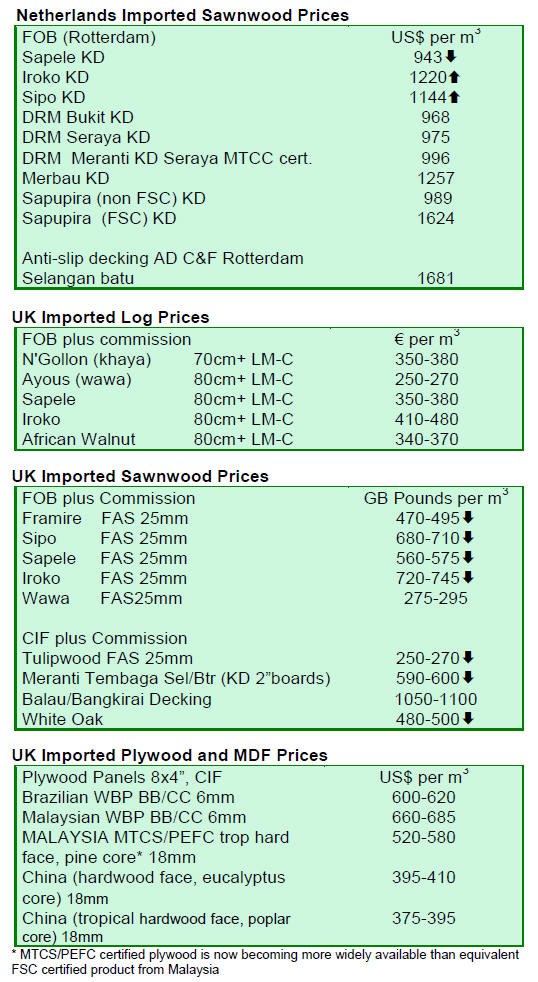
¡¡ Related News:
|